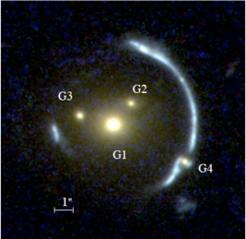Simona Vegetti starts her own junior research group at MPA
Using gravitational lensing to constrain the distribution of dark matter is by now a well-established tool in astrophysics. Simona Vegetti, however, uses it for a very specific purpose: using high-resolution images of strong gravitational lenses, she tries to find and constrain the properties of small satellite galaxies in the distant universe. Recently she has been awarded a Max Planck Junior Research Group position at MPA, which will allow her much more extensive studies using this technique with her own small group.
The nature of dark matter and how galaxies form are two major issues of modern Cosmology. Numerical simulations of galaxy formation have shown that the amount of mass substructure in galaxies strongly depends on the assumed nature of dark matter. However, dark matter cannot be directly observed and using luminous matter as a tracer is not always reliable. Therefore, Simona Vegetti will use the gravitational lensing effect, where light from a distant source galaxy is deflected (and distorted) by a large mass concentration on its way to the observer.

Already during her PhD in Groningen and later as a postdoc at MIT she developed the technique: In strong gravitational lens systems, such as galaxy clusters, individual (small) galaxies can induce small perturbations on the observed lensing features, such as arcs. These perturbations then reveal details about the lensing galaxy, allowing the scientist to measure the mass substructures in gravitational lens galaxies, galaxy-groups and galaxy-clusters.
Recently, her technique could be extended to also study in great details high-redshift lensed galaxies observed with new radio interferometers (see Link to MPA News on the right). While her research so far has been confined to fairly massive substructures, the advent of much more sensitive and high resolution data from radio interferometry systems will allow her to study much smaller galaxies, down to about 106 solar masses, and a wide range of cosmological epochs.
“By extending our studies to lower masses, we reach a regime where the predictions from different dark matter and galaxy formation models differ significantly,” explains Simona Vegetti. “Therefore this will allow us to constrain the properties of dark matter and test the standard cosmological theory of galaxy formation.”

Max Planck Junior Research Groups are established as smaller, independent research units, often supplementing departments at Max Planck Institutes, such as at MPA. The groups offer young junior scientists who hold a doctorate an exceptional opportunity to further qualify themselves on a very high level. Simona Vegetti has been appointed for a five-year term and from October, when she officially starts her new position, she will build up her own small group of two PhD students and two postdocs to work together on this specific research topic.
“Gravitational lensing and cosmology have always held a special fascination for me,” Simona points out, “ever since the first course that I attended during my undergraduate studies at Turin University. It is great that I can really delve into this subject now with my own group.” And MPA provides not only the perfect professional environment to do this; it is also close to the Alps, where she likes to go backpacking, and closer to Italy to visit friends and family.

